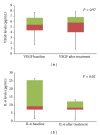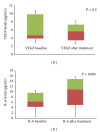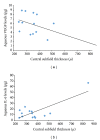Aqueous interleukin-6 levels are superior to vascular endothelial growth factor in predicting therapeutic response to bevacizumab in age-related macular degeneration
- PMID: 25110587
- PMCID: PMC4121253
- DOI: 10.1155/2014/502174
Aqueous interleukin-6 levels are superior to vascular endothelial growth factor in predicting therapeutic response to bevacizumab in age-related macular degeneration
Abstract
Objective. To prospectively evaluate the effect of intravitreal bevacizumab on aqueous levels of interleukin-6 (IL-6) and vascular endothelial growth factor (VEGF) in patients with exudative age-related macular degeneration (AMD) and correlate clinical outcomes with cytokine levels. Methods. 30 eyes of 30 patients with exudative AMD underwent intravitreal injection of bevacizumab three times at monthly intervals. The aqueous samples prior to the 1st injection (baseline) and 3rd injection were analyzed for VEGF and IL-6 levels. Subjects were subgrouped based upon change in the central subfield (CSF) macular thickness on SD-OCT at 8 weeks. Group 1 included patients (n = 14) with a decrease in CSF thickness greater than 10% from the baseline (improved group). Group 2 included patients (n = 16) who had a decrease in CSF thickness 10% or less (treatment-resistant). Results. In subgroup analysis, in both groups 1 and 2 patients, compared to aqueous VEGF, aqueous IL-6 levels showed a better correlation with CSF thickness on SD-OCT (r = 0.72 and 0.71, resp.). Conclusions. Aqueous IL-6 may be an important marker of treatment response or resistance in wet macular degeneration. Future therapeutic strategies may include targeted treatment against both VEGF and IL-6, in patients who do not respond to anti-VEGF treatment alone.
Figures





References
-
- Congdon N, O'Colmain B, Klaver CC, et al. Causes and prevalence of visual impairment among adults in the United States. Archives of Ophthalmology. 2004;122(4):477–485. - PubMed
-
- Seddon J, Chen C. The epidemiology of age related macular degeneration. In: Heier J, editor. Controversies and Advancement in the Treatment of Retinal Disease. Philadelphia, Pa, USA: Lippincott Williams & Wilkins; 2004. pp. 17–39.
-
- Green WR. Histopathology of age-related macular degeneration. Molecular Vision. 1999;5:27–36. - PubMed
-
- Duh EJ, Yang HS, Haller JA, et al. Vitreous levels of pigment epithelium-derived factor and vascular endothelial growth factor: implications for ocular angiogenesis. American Journal of Ophthalmology. 2004;137(4):668–674. - PubMed
-
- Aiello LP, Avery RL, Arrigg PG, et al. Vascular endothelial growth factor in ocular fluid of patients with diabetic retinopathy and other retinal disorders. The New England Journal of Medicine. 1994;331(22):1480–1487. - PubMed
LinkOut - more resources
Full Text Sources
Other Literature Sources

